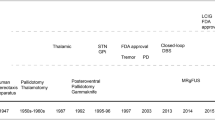Abstract
Levodopa is a highly effective treatment of all motor symptoms of Parkinson’s disease. However, long-term treatment with levodopa can lead to motor fluctuations and levodopa-induced dyskinesias. Motor side effects can become so disabling as to warrant surgical treatment. Both ablative surgery and deep brain stimulation (DBS) for Parkinson’s disease (PD) can be performed in different target areas. Thalamic surgery mainly improves tremor, and to a lesser extent also rigidity and dyskinesias, whereas pallidal and subthalamic nucleus surgery improves all motor symptoms and levodopa-induced dyskinesias. The efficacy and safety of unilateral pallidotomy is well established. DBS has a lower morbidity and is safe enough to be performed bilaterally. The subthalamic nucleus (STN) presently seems to be the most promising target for DBS in advanced stage PD.
Similar content being viewed by others
Author information
Authors and Affiliations
Rights and permissions
About this article
Cite this article
Krack, P., Poepping, M., Weinert, D. et al. Thalamic, pallidal, or subthalamic surgery for Parkinson’s disease?. J Neurol 247 (Suppl 2), 122–134 (2000). https://doi.org/10.1007/PL00022913
Issue Date:
DOI: https://doi.org/10.1007/PL00022913




